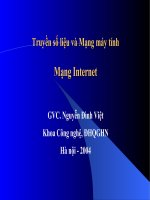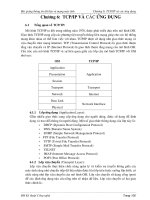Hệ thống PACS và mạng máy tính, hệ thống lưu trữ dữ liệu trong bệnh viện y tế
Bạn đang xem bản rút gọn của tài liệu. Xem và tải ngay bản đầy đủ của tài liệu tại đây (2.75 MB, 73 trang )
Computers in Medical Imaging – Chapter 4
Computer Networks, PACS and
Teleradiology – Chapter 17
Brent K. Stewart, PhD, DABMP
Professor, Radiology and Medical Education
Director, Diagnostic Physics
a copy of this lecture may be found at:
/>
Brent K. Stewart, PhD, DABMP
2
Outline
¬
¬
¬
¬
¬
¬
¬
¬
Storage and Transfer of Data in Computers
Analog Data and Conversion between Analog and Digital
Forms
Components and Operations of Computers
Performance of Computer Systems
Computer Software
Storage, Processing and Display of Digital Images
Computer Networks
PACS and Teleradiology
Brent K. Stewart, PhD, DABMP
3
Brent K. Stewart, PhD, DABMP
4
Decimal Form (Base 10)
¬
¬
¬
¬
In general, a positional numbering system encodes the
numbers as: anbn + an-1bn-1 + . . . + a2b2+ a1b1+ a0b0 (0 <
ai < b, i = 0,1,2,...,n), where the integer b > 1 is the radix
(or base) of the numbering system
The leftmost digit is called the most significant digit, the
rightmost the least significant digit
Whenever it is not clear which base is being used either
a subscript will be used to denote it or the base will be
written in parentheses
Decimal form (radix 10): 4210 = (4x101)+(2x100)
Brent K. Stewart, PhD, DABMP
5
Binary Form (Base 2)
¬
¬
¬
Powers of 2: 1, 2, 4, 8, 16, 32, 64, 128, 256, 512, 1024...
Binary form (radix 2): 1010102 = (1x25)+(0x24)+
(1x23)+(0x22)+ (1x21)+(0x20) = 3210 + 810 + 210 = 4210
Other radices used in computing
¬
¬
Octal (b=8)
Hexadecimal (b=16; A=10, … F=15)
Brent K. Stewart, PhD, DABMP
6
Conversion between Decimal and Binary Forms
¬
Conversions between decimal
and binary forms: keep
dividing by powers of the target
radix until you are left with a
remainder < b
Bushberg, et al., The Essential Physics of Medical Imaging,
2nd ed., pp. 6262-63.
Brent K. Stewart, PhD, DABMP
7
Digital Representation of Data (1)
¬
Bits, Bytes and Words
¬
¬
¬
¬
Smallest unit of storage capacity = 1 bit (binary digit:1 or 0)
Bits grouped into bytes: 8 bits = byte
Word = 16, 32 or 64 bits, depending on the computer system
addressing architecture
Computer storage capacity is measured in:
¬
¬
¬
¬
kilobytes (kB) - 210 bytes = 1024 bytes ≈ a thousand bytes
megabytes (MB) - 220 bytes = 1024 kilobytes ≈ a million bytes
gigabytes (GB) - 230 bytes = 1024 megabytes ≈ a billion bytes
terabytes (TB) - 240 bytes = 1024 gigabytes ≈ a trillion bytes
Brent K. Stewart, PhD, DABMP
8
Digital Representation of Data (2)
¬
Digital Representation of Different Types of Data
¬
¬
Alphanumeric text, integers, and non-integer data
Storage of Positive Integers
¬
¬
¬
¬
¬
¬
In general, n bits have 2n possible permutations and can
represent integers from 0 to 2n-1 (the range usually denoted with
square brackets):
n bits represents 2n values with range [0, 2n-1]
8 bits represents 28 = 256 values with range [0, 255]
10 bits represents 210 = 1024 values with range [0, 1023]
12 bits represents 212 = 4096 values with range [0, 4095]
16 bits represents 216 = 65,536 values with range [0, 65535]
Brent K. Stewart, PhD, DABMP
9
Digital Representation of Data
¬
Binary Representation of Signed Integers
¬
¬
¬
¬
Floating Point Form
¬
¬
¬
23
For very large or very small numbers (e.g., 6.023 x 1023)
010011112
Similar to scientific notation: 0.111111112 x 2
Binary Representation of Alphanumeric text
¬
¬
¬
¬
Include the use of negative numbers
Reserve first bit for the sign (+/-): [-127,127] – one’s complement
Two’s complement: [-128, 127] – simplifies electronic circuitry
ASCII = American Standard Code for Information Interchange
ASCII code for representation of text, e.g., A = 01000001
Stored in one byte (128 characters)
Computer needs to keep track of the data type
Brent K. Stewart, PhD, DABMP
10
Transfers of Data in Digital Form
¬
¬
¬
¬
¬
¬
Data are transferred between the various components of
the computer and with devices external to the computer
in binary format
A voltage of fixed value (e.g., +5V) is used to represent 1
Another voltage value (e.g., 0V) is used to represent 0
Changes between the voltage states occur through
synchronization signals from the computer’s clock
1 clock cycle = the minimum time increment (τ) at which
a1
0 or 0
1 transition can occur
clock frequency = 1/τ (usually given in MHz or GHz)
Brent K. Stewart, PhD, DABMP
11
Serial vs. Parallel Transfer of Data
¬
¬
Serial - pulses transmitted one after another over single wire
Parallel - All pulses transmitted simultaneously over several wires
¬
¬
If N wires are used, parallel transmission is predominantly N times
faster than serial transmission
Bus: a bundle of wires used for parallel data transfers
Bushberg, et al., The Essential Physics of Medical Imaging, 2nd ed., p. 66.
Brent K. Stewart, PhD, DABMP
12
Transfers of Data in Digital Form
¬
¬
¬
¬
¬
¬
Each device connected to the bus is identified by an
address or a range of addresses
Only one device at a time can transmit data on the bus
In general only one device receives the transmitted data
The sending device transmits receiving address & data
The width of a bus refers to the number of wires used to
transmit data in parallel (e.g., 32 bits)
A bus also contains wires for ground, control signaling,
etc.
Brent K. Stewart, PhD, DABMP
13
Analog and Digital
Representation of Data
¬
¬
Analog: continuous waveform
where the amplitude
represents the numerical
signal magnitude
Advantages of digital:
¬
¬
¬
¬
resistance to accumulated
errors
error correction possible with
the transmission of redundant
information
digital circuitry most often less
expensive than analog
Advantage of analog:
¬
Often transmitted quicker
Bushberg, et al., The Essential Physics of Medical Imaging,
2nd ed., p. 67.
Brent K. Stewart, PhD, DABMP
14
Conversion of Analog Data to Digital Form
¬
¬
¬
The electronic measuring devices of medical scanners (e.g.,
transducers and detectors) produce analog signals
Analog to digital conversion (analog to digital converter – ADC)
ADCs characterized by
¬
¬
sampling rate or frequency (e.g., samples/sec – 1 MHz)
number of bits output per sample (e.g., 12 bits/sample = 12-bit ADC)
Bushberg, et al., The Essential Physics of Medical Imaging, 2nd ed., p. 69.
Brent K. Stewart, PhD, DABMP
15
ADC Potential Loss of Data
¬
¬
¬
Sampling and quantization (digitization): loss of data (necessary
evil)
Minimum sampling frequency (Nyquist limit) to accurately represent
signal
Quantization error minimized through use of large number of
bits/sample
Bushberg, et al., The Essential Physics of Medical Imaging, 2nd ed., p. 69.
Brent K. Stewart, PhD, DABMP
16
Back to the Future
“I think there is a world market for
maybe five computers.”
- Thomas Watson, chairman of IBM, 1943
Brent K. Stewart, PhD, DABMP
17
Components & Function of a Digital Computer
Bushberg, et al., The Essential Physics of Medical Imaging, 2nd ed., pp. 70 and 78.
Brent K. Stewart, PhD, DABMP
18
Main Memory
¬
¬
¬
¬
¬
¬
¬
¬
Random access memory
(RAM): volatile
Buffer between CPU and mass
storage devices
Memory addresses where data
and instructions reside
Also read-only memory (ROM):
static
DRAM: dynamic RAM
SRAM: static RAM (cache)
VRAM: video RAM (display
card)
All RAM volatile!
Brent K. Stewart, PhD, DABMP
Bushberg, et al., The Essential Physics of
Medical Imaging, 2nd ed., p. 71.
19
Central Processing Unit (CPU)
¬
¬
¬
CPU executes a sequence of instructions: program
A CPU contained on a single chip: microprocessor
A number of data storage locations: storage registers
¬
¬
¬
¬
¬
Data
Memory addresses
Arithmetic Logic Unit (ALU)
Logic operations and data transfer signaled via clock
CPU speed measured in instructions or operations per
second (e.g., MIPS or GFLOPS) and determined by:
¬
¬
CPU clock rate (e.g., MHz or GHz)
Architecture (bits per instruction, e.g., 32-bit vs. 64-bit and
parallel processing capabilities)
Brent K. Stewart, PhD, DABMP
20
Central Processing Unit (CPU)
¬
CPU program execution
¬
¬
¬
A program is a sequence of
instructions for CPU execution
Instruction cycle - CPU fetches
the instructions from memory and
executes them sequentially
An instruction may cause the CPU
to perform one of the following:
¬
¬
¬
¬
¬
Mathematical operation
Transfer data
Compare
Jump to an instruction other than
the next in the sequence
Each instruction consists of two
parts: an opcode specifying the
operation to be performed and an
address
Brent K. Stewart, PhD, DABMP
21
Input-Output (I/O) Bus and Expansion Slots
¬
¬
Bus described under serial vs. parallel data transfer
Most I/O buses are provided with expansion slots to
accommodate printed circuit (PC) cards with multiple
functions, e.g.:
¬
¬
¬
Modem card
modem and video display card
video monitor
Makes it possible to customize general-purpose
computers for specific applications (e.g., MRI scanner)
and to add additional functions and capabilities (e.g.,
ADC)
I/O Ports: serial, parallel, USB (Universal Serial Bus) and
SCSI (Small Computer System Interface)
Brent K. Stewart, PhD, DABMP
22
Mass Storage Devices
¬
¬
Permit the non-volatile storage of programs and data
Various formats based on:
¬
¬
¬
¬
¬
¬
All consist of:
¬
¬
¬
¬
Access time (e.g., msec or minutes): random or sequential
Data transfer rate (e.g., kbps, Mbps or Gbps)
Cost
Portability
Permanence (CD-R vs. CD-RW)
Mechanical drive
Storage medium
Controller
Hierarchical: trade-off speed vs. cost per MB
Brent K. Stewart, PhD, DABMP
23
Mass Storage Devices
Bushberg, et al., The Essential Physics of Medical Imaging, 2nd ed., p. 76.
Brent K. Stewart, PhD, DABMP
24
Display Interface and Keyboard/Pointing Devices
¬
¬
Display computer information in visual form
Usually displayed on a video monitor or printed
¬
¬
¬
Video display controller/card
¬
¬
¬
¬
¬
Cathode ray tube (CRT)
Flat-panel display (TFT = thin-film transistors)
Receive digital data from computer memory
Store locally on card with VRAM (video RAM)
Registers to manipulate the original image or text data
DACs to convert into on-screen video image
Usually computer equipped with keyboard, mouse,
trackball or joystick (could be head-less though)
Brent K. Stewart, PhD, DABMP
25
Acquisition and Communications Interface
¬
¬
¬
¬
¬
Acquisition interface = ADC card(s), though more
efficient for the modality electronics to perform ADC
Computers also communications devices (PACS)
Modem = modulator/de-modulator (DAC - encoded
signal on wire - ADC)
Network interface card (NIC), e.g., Ethernet
Needs unique address on the network
¬
¬
Phone number of modem pool, e.g., 206-685-5599
Internet Protocol (IP) address, e.g., 128.95.120.1
Brent K. Stewart, PhD, DABMP









